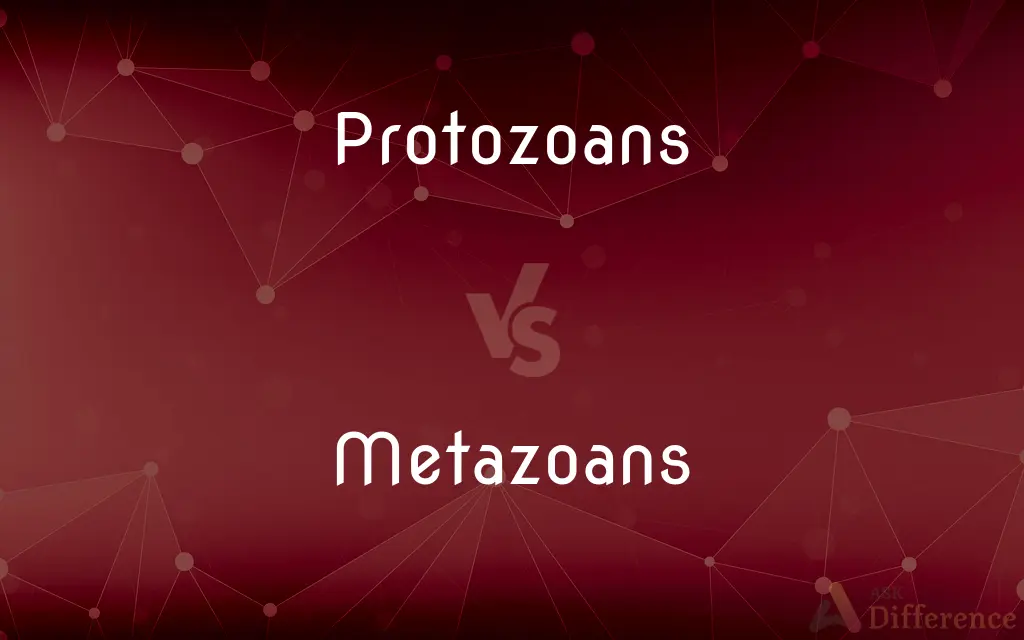Protozoans vs. Metazoans — What's the Difference?
Edited by Tayyaba Rehman — By Fiza Rafique — Published on January 11, 2024
Protozoans are single-celled organisms, whereas Metazoans are multicellular animals with complex structures.

Difference Between Protozoans and Metazoans
Table of Contents
ADVERTISEMENT
Key Differences
Protozoans represent the simplest form of animal life. These organisms are unicellular, meaning they consist of a single cell performing all life processes. Protozoans are predominantly microscopic and can be found in a variety of habitats including freshwater, marine environments, and soil. Examples include amoebae, paramecia, and malaria-causing Plasmodium.
Metazoans, in contrast, are complex multicellular organisms, commonly referred to as animals. They are composed of multiple specialized cells that form tissues and organs, exhibiting a higher level of organization than protozoans. Metazoans include all animals ranging from simple sponges to complex mammals like humans.
In the context of the evolutionary tree, protozoans are considered to be among the earliest forms of life, showing how life began from simple single-celled organisms. They are often studied to understand basic biological processes. Protozoans reproduce both sexually and asexually and can be free-living or parasitic.
Metazoans evolved from protozoan ancestors but have developed a much more intricate structure and organization. Metazoan cells differentiate to perform specific functions, which is not seen in protozoans. Reproduction in metazoans can be complex, involving multiple stages including embryonic development.
Disease causation differs between protozoans and metazoans. Protozoans are responsible for diseases such as malaria and sleeping sickness, affecting individuals when protozoans invade as parasites. Metazoans do not typically cause disease directly, but parasitic metazoans like tapeworms and roundworms can cause health issues in other organisms, including humans.
ADVERTISEMENT
Comparison Chart
Cellularity
Single-celled organisms.
Multicellular organisms.
Complexity
Simple, with no tissues or organs.
Complex, with specialized tissues and organs.
Size
Mostly microscopic.
Range from microscopic to visibly large.
Reproduction
Can reproduce asexually or sexually.
Typically reproduce sexually, with a life cycle.
Examples
Amoebae, paramecia.
Sponges, insects, birds, mammals.
Compare with Definitions
Protozoans
These organisms often have simple life cycles.
The protozoan Giardia reproduces asexually, resulting in a rapid increase in population.
Metazoans
Metazoans are multicellular animals with complex structures.
Coral reefs are diverse ecosystems made up of many types of metazoans.
Protozoans
They typically move using cilia, flagella, or pseudopodia.
Protozoans like paramecia move through water with the help of cilia.
Metazoans
These organisms exhibit diverse reproductive and developmental processes.
Butterflies undergo a metamorphosis, a fascinating metazoan developmental process.
Protozoans
Protozoans can be free-living or parasitic.
Malaria is caused by Plasmodium, a protozoan that lives parasitically in humans.
Metazoans
Metazoans can be either vertebrates or invertebrates.
Insects are the most diverse group of metazoans on the planet.
Protozoans
Protozoans are unicellular organisms found in various ecosystems.
Amoebas, a type of protozoan, are often observed under the microscope in biology labs.
Metazoans
Metazoans have specialized cells and organs.
The complexity of the human brain is an example of metazoan advancement.
Protozoans
Protozoans are considered the simplest animal life forms.
In our study of protozoans, we will explore the fundamentals of cellular processes.
Metazoans
Metazoans range from simple sponges to complex vertebrates.
The evolutionary history of metazoans shows a progression from sea sponges to mammals.
Protozoans
Any of numerous chiefly single-celled eukaryotic organisms, most of which move about freely and ingest food, including the amoebas, ciliates, flagellates, and apicomplexans. Protozoans along with certain algae, oomycetes, and some other groups make up the protists.
Metazoans
Any of numerous heterotrophic eukaryotic organisms of the kingdom Metazoa, characteristically having a multicellular body with cells differentiated into tissues; an animal.
Protozoans
Plural of protozoan
Metazoans
Plural of metazoan
Common Curiosities
Do metazoans have specialized cells?
Yes, metazoans have specialized cells that form tissues and organs.
What are protozoans?
Protozoans are single-celled, often microscopic, organisms.
What distinguishes metazoans from protozoans?
Metazoans are complex multicellular organisms, unlike the single-celled protozoans.
How do protozoans obtain nutrients?
Protozoans can absorb nutrients from their environment or ingest food particles.
Are all metazoans large and visible to the naked eye?
No, some metazoans, like tiny nematodes, can be microscopic.
Do metazoans reproduce asexually?
Some metazoans can reproduce asexually, but sexual reproduction is more common.
What forms of locomotion do protozoans use?
Protozoans move using structures like cilia, flagella, or pseudopodia.
Can metazoans be found in both marine and terrestrial environments?
Yes, metazoans inhabit both marine and terrestrial ecosystems.
What types of environments do protozoans live in?
Protozoans inhabit a variety of environments including fresh and saltwater, and soil.
Are protozoans considered animals?
Yes, protozoans are categorized under the kingdom Protista but are animal-like in their nutritional needs.
Do protozoans have a role in the ecosystem?
Yes, protozoans play roles in nutrient cycling and as part of the food web.
Are sponges considered the simplest form of metazoans?
Yes, sponges are among the simplest and most primitive metazoans.
How do protozoans contribute to human health concerns?
Protozoans can be vectors of diseases or directly cause illnesses.
Can protozoans cause diseases?
Yes, some protozoans are parasitic and can cause diseases like malaria.
Why is the study of protozoans and metazoans important?
Studying these organisms helps us understand biological diversity and evolutionary biology.
Share Your Discovery

Previous Comparison
Ammonia vs. Cloudy Ammonia
Next Comparison
Fact Table vs. Dimension TableAuthor Spotlight
Written by
Fiza RafiqueFiza Rafique is a skilled content writer at AskDifference.com, where she meticulously refines and enhances written pieces. Drawing from her vast editorial expertise, Fiza ensures clarity, accuracy, and precision in every article. Passionate about language, she continually seeks to elevate the quality of content for readers worldwide.
Edited by
Tayyaba RehmanTayyaba Rehman is a distinguished writer, currently serving as a primary contributor to askdifference.com. As a researcher in semantics and etymology, Tayyaba's passion for the complexity of languages and their distinctions has found a perfect home on the platform. Tayyaba delves into the intricacies of language, distinguishing between commonly confused words and phrases, thereby providing clarity for readers worldwide.












































